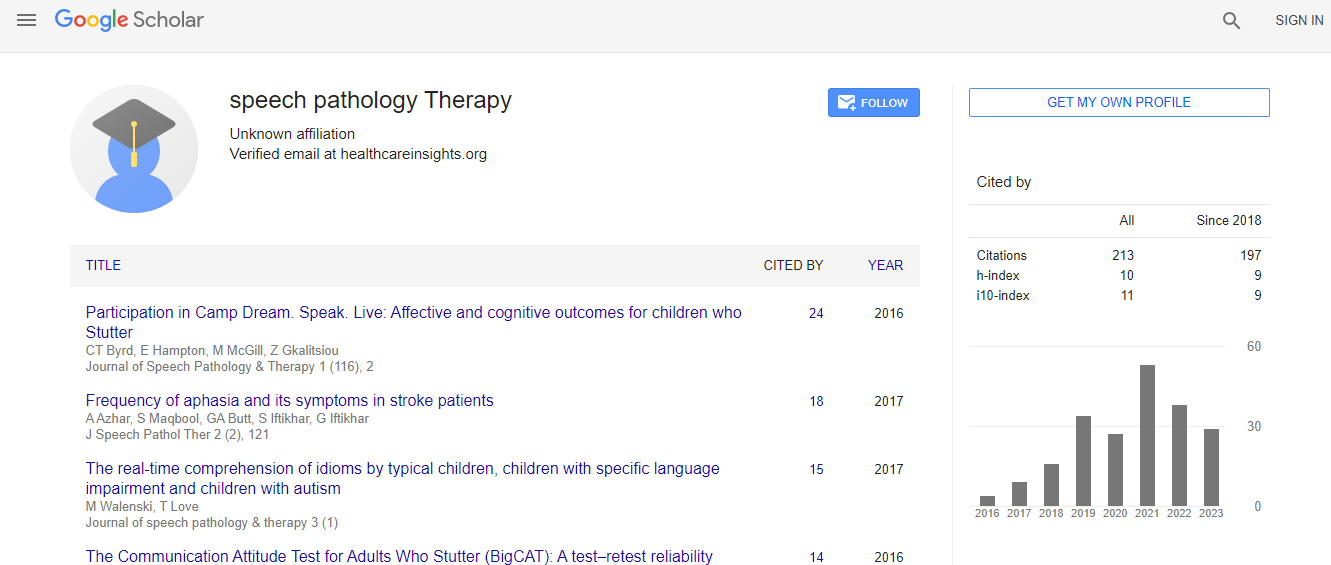Our Group organises 3000+ Global Conferenceseries Events every year across USA, Europe & Asia with support from 1000 more scientific Societies and Publishes 700+ Open Access Journals which contains over 50000 eminent personalities, reputed scientists as editorial board members.
Open Access Journals gaining more Readers and Citations
700 Journals and 15,000,000 Readers Each Journal is getting 25,000+ Readers
Google Scholar citation report
Citations : 273
Journal of Speech Pathology & Therapy received 273 citations as per Google Scholar report
Indexed In
- Google Scholar
- Open J Gate
- RefSeek
- Hamdard University
- EBSCO A-Z
- Euro Pub
- ICMJE
Useful Links
Recommended Journals
Related Subjects
Share This Page
Charles Larson

Charles Larson
Professor
Department of Communication Sciences and Disorders
Northwestern University
USA
Biography
My primary area of interest is in neural mechanisms of voice control. I have worked on this general topic for over 40 years. My early work was done on nonhuman primates in which we attempted to learn which areas of the brain are involved in vocalization through the brain lesioning approach. I also worked with Erich Luschei studying neural mechanisms of jaw control, and in this work I learned how to do single unit recordings from the brain in awake behaving animals. In this work we made important discoveries of the role of jaw muscle spindle afferent endings on jaw control (J. Neurophysiology; J Physiology (London)). Thereafter with my move to Northwestern University, I used the single unit recording methods to study neural function in the midbrain periaqueductal gray and nucleus ambiguous in monkeys as they were vocalizing. This work demonstrated that the midbrain periaqueductal gray played an important role in the coordination of laryngeal and respiratory muscles on vocal control (Brain Research, Experimental Brain Research and the Journal of Neurophysiology). In about 1995 I developed a technique to study neural control of the voice by perturbing voice auditory feedback. This work was based on the well-established technique of perturbation analysis that has been used in other motor systems. In this work, we measure voice fundamental frequency and voice amplitude changes during steady vowel vocalizations as well as during speech following perturbations in auditory feedback. This technique has been widely accepted and is now used by voice scientists around the world. Our most recent work has involved ERP recording in the voice perturbation technique, and this research has led us to insightful discoveries of brain function during human vocalization. Namely, we have determined that voice pitch perturbations presented at the onset of vocalization activate a system that is important for identification of ones own voice. Perturbations presented after the onset of vocalization trigger mechanisms that are involved in correcting for errors in vocal production. I began working with Don Robin about six years ago, and through this collaboration we have been using neuroimaging techniques (fMRI and PET) along with transcranial magnetic stimulation to study the role of auditory feedback in voice control. This work has also led to important papers on structural equation modeling and dynamic causal modeling of the neural circuitry involved in the role of auditory feedback in voice control (Neuroimage, Neuropsychologia). Most recently, working with my post doctoral fellow, Dr. Sona Patel, we developed a new technique for the study of volitional mechanisms of voice control based on perturbations in voice auditory feedback. This technique allows us to investigate neural correlates of feedforward mechanisms of voice control. All together, the voice perturbation studies, ERP recordings, fMRI neuroimaging and neural modeling are leading to a better understanding of the neural mechanisms involved in the role of auditory feedback and voice control. My background in the establishment of new techniques for the study of neural mechanisms of voice control places me in an ideal position to participate in the studies in this proposal.
Research Interest
Neural mechanisms of voice control.
 Spanish
Spanish  Chinese
Chinese  Russian
Russian  German
German  French
French  Japanese
Japanese  Portuguese
Portuguese  Hindi
Hindi 
